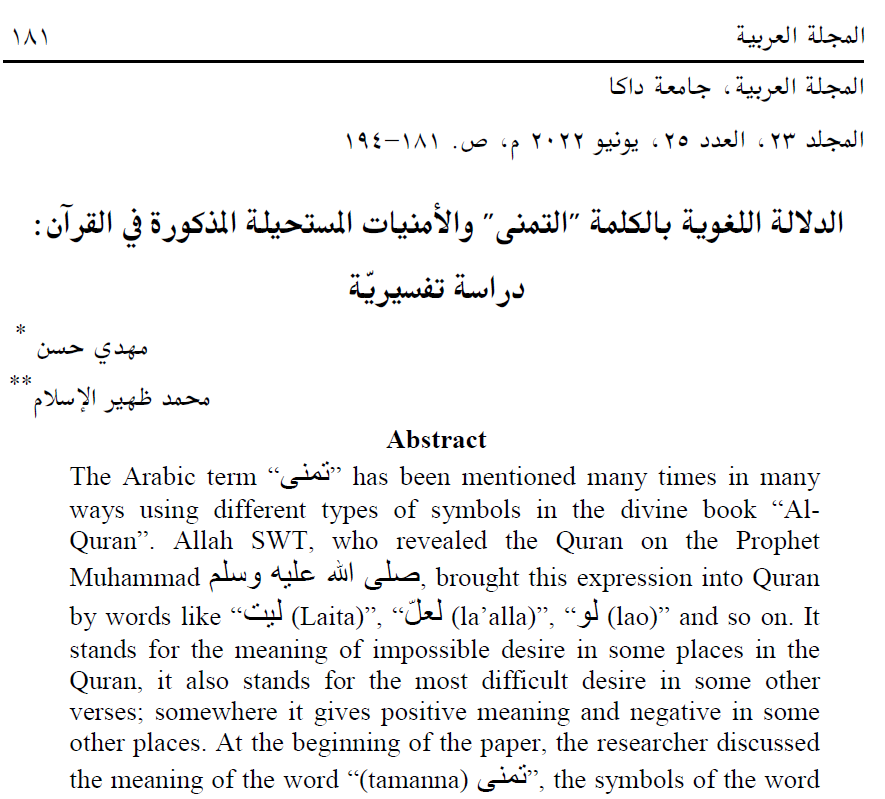الدلالة اللغوية بالكلمة "التمنى" والأمنيات المستحيلة المذكورة في القرآن: دراسة تفسيريّة
DOI:
https://doi.org/10.62295/mazallah.v23i25.2الملخص
The Arabic term “تمنى” has been mentioned many times in many ways using different types of symbols in the divine book “Al-Quran”. Allah SWT, who revealed the Quran to the Prophet Muhammad صلى الله عليه وسلم, brought this expression into Quran by words like “ليت (Laita)”, “لعلّ (la’alla)”, “لو (lao)” and so on. It stands for the meaning of impossible desire in some places in the Quran, it also stands for the most difficult desire in some other verses; somewhere it gives positive meaning and negative in some other places. At the beginning of the paper, the researcher discussed the meaning of the word “تمنى”, the symbols of the word “تمنى” has been brought into the Quran, and its linguistic meaning also has been described. To mean any impossible desire, Allah SWT used the word “ليت” in most of the verses of the Quran. There are several impossible desires mentioned in the Quran, those will be desired by the Non-believers on the Day of Judgment. The researcher has picked up seven of those impossible desires (Sura An-Nisa: 73, Sura Al-An’aam: 27, Sura Al-Furqan: 27-28, Sura Al-Ahjab: 66, Sura Al-Haqqah: 25-27, Sura Al-Naba: 40, Sura Al-Fazr: 24). He went through some well-explained Tafsir books (Explanation of the Quran) to understand the appropriate analysis of those desires, the context of those verses, the background story of the revelation of those verses, and the lessons for the believers from those verses. The descriptive-explanatory method has been followed to find out the scholarly explanations as well as to analyze the findings in the most accurate way. From some of the highly accepted tafsir books, explanations of those verses have been discussed in this paper accordingly. Afterward, the research divided those impossible desires into positive and negative desires. At the end of the paper, the researcher presented some messages to the believers in Allah, in the holy books, and on the day of resurrection.
المراجع
Al Qurān al-Karīm.
Ibn Al-Sarrāj, Abū Bakr (Ed. Abul Ḥusain al-Futli). 1988. Al-Uṣūl Fī al-Naḥw. Beirut: Muassasah Risālah.
Ibn Manẓūr, Jamāl al-Dīn. 1414 H. Lisān al-‘Arab. Beirut: Dār Ṣādir.
Ibn Hishām, Jamāl al-Dīn Al-Anṣārī. 1972. Mughnī al-Labīb ‘an Kutub al-A‘ārīb. Aleppo: Matba‘ah Jamiaru Halb.
Al- Zamakhsharī, Jarullah. 1407 H. Al-Kashshāf ‘an Haqā'iq al-Tanzīl. Beirut: Dār al-Kitāb al-‘Arabī.
Al-Sha‘rāwī, Muḥammad Mutwallī. 1997. Tafsīr al-Sha‘rāwī. Cairo: Maṭābi‘ Akhbār al-Yawm.
Al- Ṭabarī, Abu Ja‘far. 2000. Jāmi‘ al-Bayān ‘an Tā’wīl āy al-Qurān. Beirut: Muassasah al-Risālah.
Al-‘Ākūb, ‘Isā ‘Alī. 2018. Al-Mufaṣṣal Fī ‘Ulūm Balāghah al-‘Arabiyyah. Aleppo: Manshūrah Jāmiah Halb.
Ghalayini, Mustafa. 1968. Jāmi‘ al-Durūs al-‘Arabiyyah. Beirut: Al Maktabah al-‘Asriyyah.
Al-Farāhīdī, Al-Khalīl Ibn Aḥmad (ed. ‘Abd al-Ḥamīd Hindāwī). 2002. Kitāb Al-‘Ain. Beirut: Dār al-Kutub al-‘IImiyyah.
Al-Fairuzābādī, Abu Ṭahir Muḥammad Ibn Ya‘qūb. 2005. Al-Qāmūs al-Mūhīt. Beirut: Muassasah al-Risālah.
Al-Qurṭubī, Shamsuddīn. 1964. Al-Jāmi‘ li Aḥkām Al-Qurān. Cairo: Dār al-Kutub al- Miṣriyyah.
Bakir, Mahmud Ali. 2000. Mashāhid al-Tamannī Fī Qurān al-Karīm. Majallatu Usulid Din, Jamiatu Aralik.


